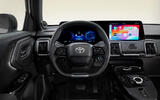Toyota has revived the Urban Cruiser nameplate for its new electric crossover.
Adding a second electric car to the brand's line-up is seen as crucial for the Japanese firm to hit tightening emissions goals – the UK’s ZEV mandate rises to a 28% EV sales mix in 2025 – with low bZ4X sales (7576) meaning it missed this year’s target by nearly 15%.
An indirect successor to the crossover that went out of production in Europe in 2014, the Urban Cruiser is positioned as a slightly larger electric equivalent to the Yaris Cross, one of Toyota's best-selling cars (18,878 UK sales). This makes it a rival to the likes of the Volvo EX40, Peugeot e-3008 and Mini Aceman in an already saturated segment.
The new car also moves the Japanese brand away from its bZ naming strategy, which was meant to badge its EVs, following Honda (e:NY) and Mercedes-Benz (EQ) in announcing they will ditch numerical or alphabetical designation.
The Urban Cruiser is twinned with the already revealed Suzuki e-Vitara, making it the first time Suzuki has led a vehicle project between the two car makers.
It will be produced alongside its sibling in India, coincidentally in one of the few markets (along with Africa and the Middle East) where the Urban Cruiser moniker is still in use for a rebadged Suzuki Grand Vitara.
Like the e-Vitara, the electric five-seat Urban Cruiser sits on Suzuki’s new Heartect-e architecture, adapted from the scalable platform that underpins a range of models, including the Swift hatchback.
 This can be had with one of two battery options: 49kWh or 61kWh. Power outputs depend on the battery selected. A 142bhp front-mounted motor is offered on the smaller pack and a 172bhp motor with the larger pack. Both options put out the same 140lb ft of torque.
This can be had with one of two battery options: 49kWh or 61kWh. Power outputs depend on the battery selected. A 142bhp front-mounted motor is offered on the smaller pack and a 172bhp motor with the larger pack. Both options put out the same 140lb ft of torque.
















Join the debate
Add your comment
If you think the price is too high, worry not - you'll be able to buy these after a year with 50-60% depreciation from the brand new price.
I don't find the styling too offensive, but why do some manufacturers insist on that keeping that stupid fad for hidden rear door handles going? And the pointless uptick of bodywork cutting in on rear windows that reduces visibility and increases travel sickness?
That aside, it's a pointless debate if the pricing is as ridiculous as all EVs with over 200 miles of range. Especially as Toyota regard themselves as a premium brand now, and Suzuki seem to be doing the same - e.g. the lightest of refreshes of the latest Vitara has not only made the styling worse, it's included a huge price hike too.
1. It provides more metal around the c/d-pillar, increasing safety/rigidity while minimising added weight
2. It doesn't make people car sick.
Too expensive.